The Kaveri Refresh 'Godavari' Review: Testing AMD's A10-7870K
by Ian Cutress on June 1, 2015 11:59 AM ESTGaming Benchmarks: High End
Alien: Isolation
If first person survival mixed with horror is your sort of thing, then Alien: Isolation, based off of the Alien franchise, should be an interesting title. Developed by The Creative Assembly and released in October 2014, Alien: Isolation has won numerous awards from Game Of The Year to several top 10s/25s and Best Horror titles, ratcheting up over a million sales by February 2015. Alien: Isolation uses a custom built engine which includes dynamic sound effects and should be fully multi-core enabled.
For low end graphics, we test at 720p with Ultra settings, whereas for mid and high range graphics we bump this up to 1080p, taking the average frame rate as our marker with a scripted version of the built-in benchmark.
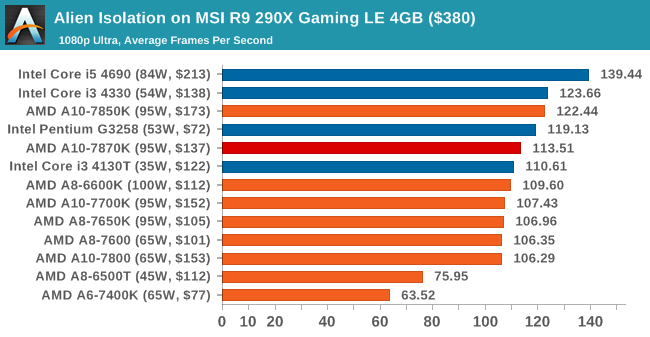

Total War: Attila
The Total War franchise moves on to Attila, another The Creative Assembly development, and is a stand-alone strategy title set in 395AD where the main story line lets the gamer take control of the leader of the Huns in order to conquer parts of the world. Graphically the game can render hundreds/thousands of units on screen at once, all with their individual actions and can put some of the big cards to task.
For low end graphics, we test at 720p with performance settings, recording the average frame rate. With mid and high range graphics, we test at 1080p with the quality setting. In both circumstances, unlimited video memory is enabled and the in-game scripted benchmark is used.

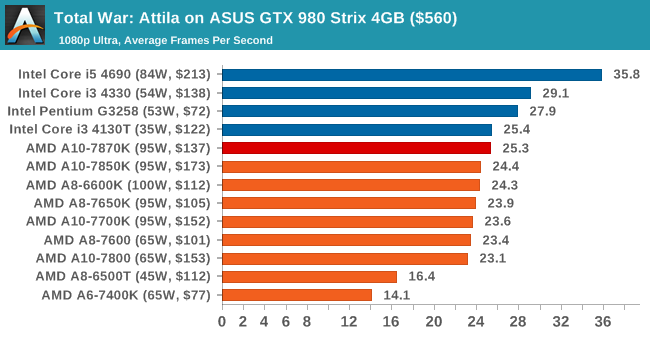
Grand Theft Auto V
The highly anticipated iteration of the Grand Theft Auto franchise finally hit the shelves on April 14th 2015, with both AMD and NVIDIA in tow to help optimize the title. GTA doesn’t provide graphical presets, but opens up the options to users and extends the boundaries by pushing even the hardest systems to the limit using Rockstar’s Advanced Game Engine. Whether the user is flying high in the mountains with long draw distances or dealing with assorted trash in the city, when cranked up to maximum it creates stunning visuals but hard work for both the CPU and the GPU.
For our test we have scripted a version of the in-game benchmark, relying only on the final part which combines a flight scene along with an in-city drive-by followed by a tanker explosion. For low end systems we test at 720p on the lowest settings, whereas mid and high end graphics play at 1080p with very high settings across the board. We record both the average frame rate and the percentage of frames under 60 FPS (16.6ms).
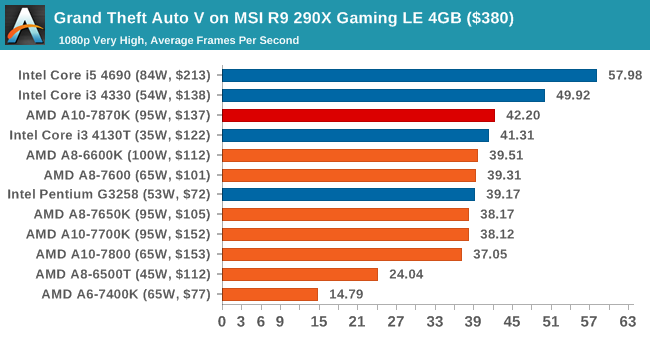
![Grand Theft Auto V on MSI R9 290X Gaming LE 4GB ($380) [Under 60 FPS]](https://images.anandtech.com/graphs/graph9307/74894.png)
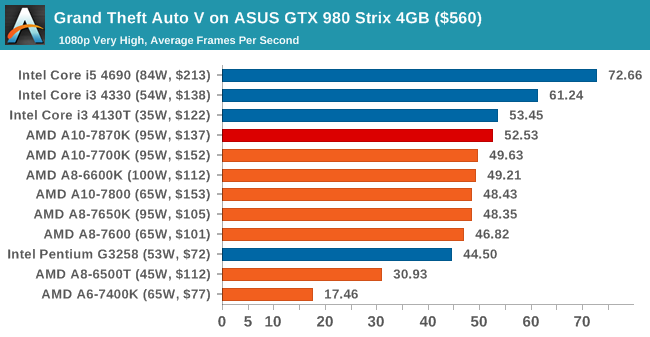
![Grand Theft Auto V on ASUS GTX 980 Strix 4GB ($560) [Under 60 FPS]](https://images.anandtech.com/graphs/graph9307/74906.png)
GRID: Autosport
No graphics tests are complete without some input from Codemasters and the EGO engine, which means for this round of testing we point towards GRID: Autosport, the next iteration in the GRID and racing genre. As with our previous racing testing, each update to the engine aims to add in effects, reflections, detail and realism, with Codemasters making ‘authenticity’ a main focal point for this version.
GRID’s benchmark mode is very flexible, and as a result we created a test race using a shortened version of the Red Bull Ring with twelve cars doing two laps. The car is focus starts last and is quite fast, but usually finishes second or third. For low end graphics we test at 1080p medium settings, whereas mid and high end graphics get the full 1080p maximum. Both the average and minimum frame rates are recorded.
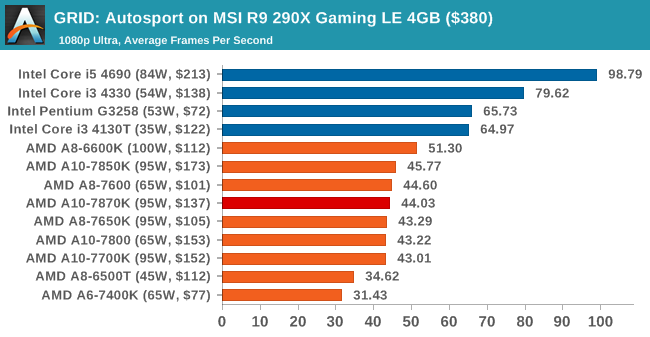
![GRID: Autosport on MSI R9 290X Gaming LE 4GB ($380) [Minimum FPS]](https://images.anandtech.com/graphs/graph9307/74896.png)
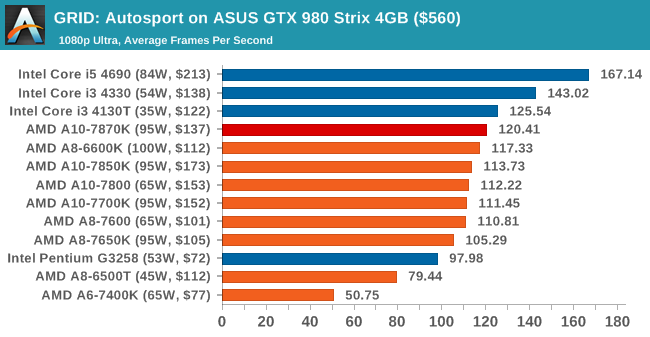
![GRID: Autosport on ASUS GTX 980 Strix 4GB ($560) [Minimum FPS]](https://images.anandtech.com/graphs/graph9307/74908.png)
Middle-Earth: Shadows of Mordor
The final title in our testing is another battle of system performance with the open world action-adventure title, Shadows of Mordor. Produced by Monolith using the LithTech Jupiter EX engine and numerous detail add-ons, SoM goes for detail and complexity to a large extent, despite having to be cut down from the original plans. The main story itself was written by the same writer as Red Dead Redemption, and it received Zero Punctuation’s Game of The Year in 2014.
For testing purposes, SoM gives a dynamic screen resolution setting, allowing us to render at high resolutions that are then scaled down to the monitor. As a result, we get several tests using the in-game benchmark. For low end graphics we examine at 720p with low settings, whereas mid and high end graphics get 1080p Ultra. The top graphics test is also redone at 3840x2160, also with Ultra settings, and we also test two cards at 4K where possible.
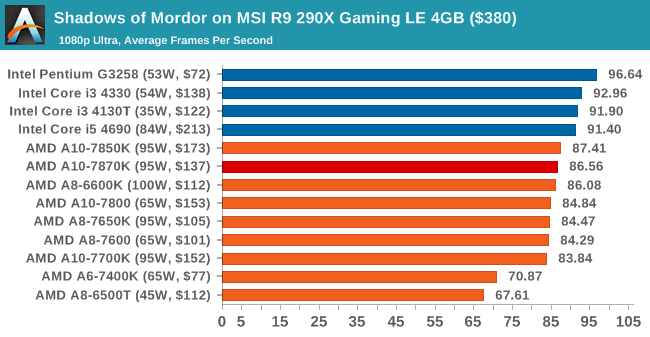
![Shadows of Mordor on MSI R9 290X Gaming LE 4GB ($380) [Minimum FPS]](https://images.anandtech.com/graphs/graph9307/74898.png)
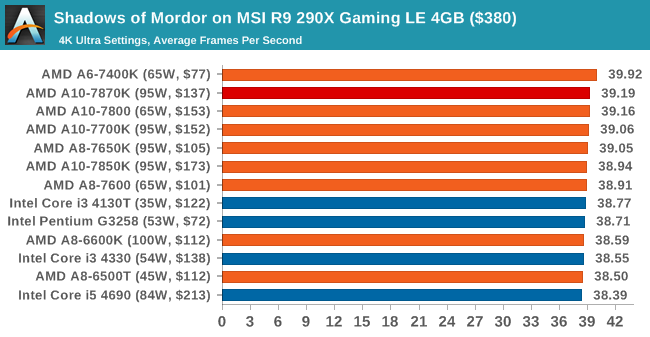
![Shadows of Mordor on MSI R9 290X Gaming LE 4GB ($380) [Minimum FPS]](https://images.anandtech.com/graphs/graph9307/74900.png)
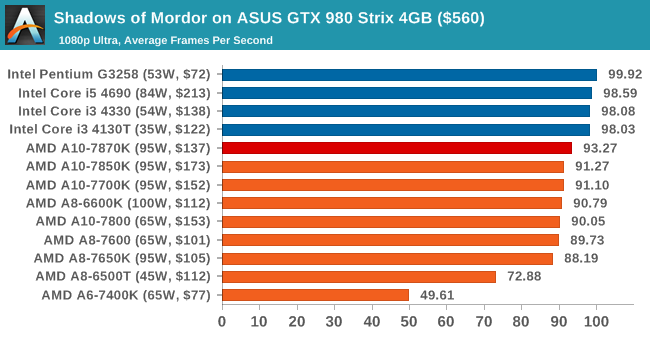
![Shadows of Mordor on ASUS GTX 980 Strix 4GB ($560) [Minimum FPS]](https://images.anandtech.com/graphs/graph9307/74910.png)
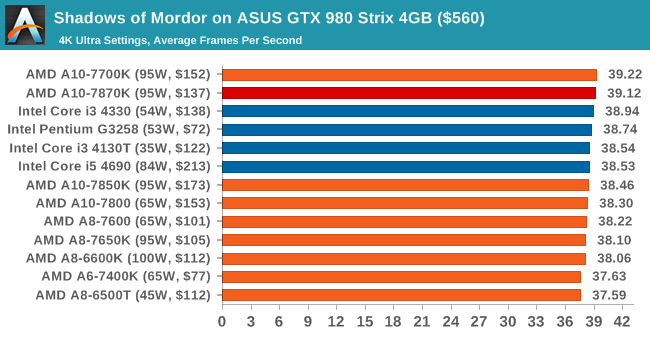
![Shadows of Mordor on ASUS GTX 980 Strix 4GB ($560) [Minimum FPS]](https://images.anandtech.com/graphs/graph9307/74912.png)
Shadows of Mordor, Dual-GPU
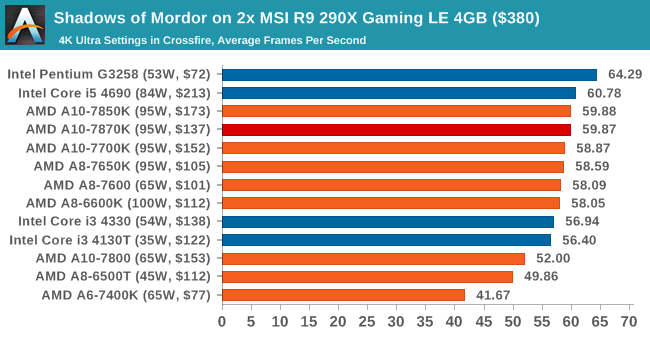
![Shadows of Mordor on 2x MSI R9 290X Gaming LE 4GB ($380) [Minimum FPS]](https://images.anandtech.com/graphs/graph9307/74902.png)
Conclusions on High-End Graphics
Moving to faster GPUs and higher resolutions pushes the burden away from the processor and more onto the graphics cards, so as a result some of the titles here, on some GPU combinations, see little gain moving up through the processor stack. That being said, some titles (like Alien Isolation, GRID and Mordor on a GTX 980) love the horse power under the hood and AMD can have a hard time keeping up here against the blue team. I wouldn’t be surprised if AMD is hoping that DirectX 12 levels the playing field in this regard.















140 Comments
View All Comments
Travis26 - Monday, June 1, 2015 - link
I completely agree that APUs make little sense for gaming at their current prices. I got an R7 260x for $90 and an athlon x4 750k for $75. This comes to a total of $165 for cpu/gpu whereas the kaveri apus at were I think $120 for much worse gaming performance. I also didn't need to worry very much about the speed of my RAM. I went with a single 4 GB stick of DDR3 1600 which allows me to upgrade to 8GB later by dropping in another stick. Had I gone with an APU, I would have had to go with dual channel which would make me decide between being stuck with 4GB or spending another $40 to get 8 GB. The RAM also would have cost more to get 2133 or 2400 RAM. I also was able to get the motherboard for $25 because they were clearing out FM2 motherboards. So I was able to get a better PC for likely the same price as a kaveri APU based build, but with much better performance. For laptops however, they might make sense. Another way they might make sense now is if you don't plan on overclocking, you might spend the extra $10 to go from an Athlon x4 to an a8 7600 hoping that DirectX 12 will be able to offload some stuff to the APU's GPU and improve performance, but I don't think that it is worth it especially if you would need to buy faster RAM when you could simply jump up to the next level of GPU for guaranteed better performance.neo_1221 - Monday, June 1, 2015 - link
The A10-7850K by any other name...johnpombrio - Monday, June 1, 2015 - link
With Intel having 83% share of the desktop, 93% in desktops, and NVidia with 76% share of the discrete GPU graphics, AMD is finding out that price/performance is not working for them. Yes, this is low cost and has good internal graphics but is it enough to even slow down the Intel/NVidia juggernauts? AMD needs to do better, but time and it's abysmal low amount of spending on R&D is not going to get it there.Lolimaster - Monday, June 1, 2015 - link
They could actually release Carrizo to improve IGP performance. Just ditch cpu turbo and allow resource for the gpu.ex:
A10 8850K 3.8Ghz no turbo 900Mhz 768SP gpu.
fw1374 - Monday, June 1, 2015 - link
I wish you throw some FX series CPU (like FX 6300) into these benchmarks.Oxford Guy - Monday, June 1, 2015 - link
FX 8320E is the best bang for the buck, especially from Microcenter. Pair it with a halfway decent cooler and you're good to go. If they're going to put in a $200+ Intel i5, why not put in a $100 FX with a discreet GPU? You could get the processor, a cooler, and a discreet GPU for the same price as that i5.In fact, if you're doing single or low threaded gaming you can set that chip to "one core per module" in the BIOS of a motherboard like the UD3P and overclock to a much higher speed on a moderately effective cooler.
Oxford Guy - Monday, June 1, 2015 - link
The processor selection employed for this article makes it look like you have to go with Intel for inexpensive performance in professional workloads, by noticeably excluding FX. While FX doesn't beat Intel in everything, for $100 (the cost of an 8320E at Microcenter, ignoring the additional $40 off a motherboard) it's going to kill the Intel chips here for value, as well as the APUs most likely.Oxford Guy - Monday, June 1, 2015 - link
It also just occurred to me that review sites like this one always overclock to extremes when they review FX. Anandtech overclocked their 8320E to 4.8 GHz at 1.55 volts. What good is that result for practical users? You need a custom water loop for ridiculous voltage like that.Anandtech should instead overclock the chip to sane level (low voltage) that an inexpensive cooler like the EVO can handle at reasonable noise levels. You can get around 4.2 GHz with a fully loaded chip and higher with "one module per core" set. Reasonable overclocking also doesn't require tons of case cooling, exotic things like fans behind the socket, and fancy motherboards.
If Anandtech is going to present their benchmark charts with processor pricing they should at least try to make those charts informative and comprehensive enough to not give people the wrong general impression. The impression one gets from these charts in that, aside from a few gaming benchmarks, one's only solution for a general-purpose chip (capable of professional workloads as well as games) is an Intel.
Cryio - Monday, June 1, 2015 - link
I can up to a 4.5 GHz on my FX 6300 at 1.392/1.404 V. I doubt it would be much different on an FX 83x0 for 4.5 GHz.Oxford Guy - Tuesday, June 2, 2015 - link
1.4 is a lot more voltage than the 1.28 or so needed for around 4.2 on an 8320E. Trying to get Prime stability with an 8 core at 1.4V requires much better cooling.